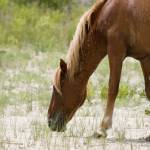Is Your Horse Ingesting Sand?

Swallowing sand is a danger for horses that graze loose, sandy soil or eat hay that is piled on sandy ground. A certain amount of ingested sand passes through the digestive tract, but in some cases, large amounts of sand can accumulate in the horse’s intestine. A heavy load of sand may irritate the intestinal lining and may also cause displacement or twisting that can lead to colic.
Owners can gather fresh feces, stir them into a quart of water, and look for sand that settles out at the bottom of the container. This test may reveal that sand is being carried out with the feces, but it can’t indicate how much has been retained in the horse’s body.
With a few management changes, owners can minimize the ingestion of sand to some extent. Feeding hay from bins, nets, or rubber ground mats makes it less likely that horses will pick up sand as they eat. Rotating fields so that they do not become overgrazed is another way to encourage horses to bite off the upper parts of forage plants rather than pulling up the entire plant and swallowing the sand that clings to the lower leaves and roots.
Owners sometimes order a load of sand to be dumped in a paddock, creating a favorite spot for horses to roll. Before doing this, be certain that the sand has not been collected from an ocean beach, as some horses love the salty taste and will tend to eat mouthfuls of sand.








